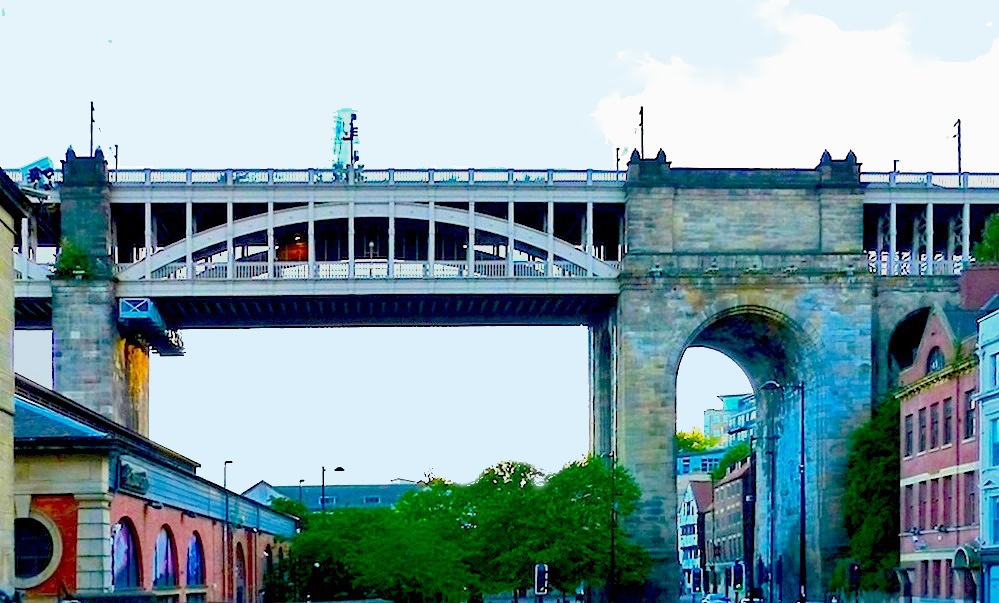
Robert Stephenson's High Level Bridge, seen behind and dwarfing the earlier Swing Bridge across the Tyne at Newcastle.
The High Level Bridge, Newcastle (1845-49), a Grade I listed structure which is a combined double-decker road and railway bridge designed by Robert Stephenson (1803-59), with Thomas Elliot Harrison (1808-88). It has been described as "a superb example of Stephenson's use of materials appropriate to their functions" (Grundy et al. 458). Harrison should have his share of credit too: according to his obituary from the Institution of Civil Engineers, "there is no doubt that Mr. Harrison equally shares with [Stephenson] all the honours of this great work." The obituary-writer explains that the bridge "was then considered a marvel of engineering design, and is still regarded with just pride by all the inhabitants of the North" ("Thomas Elliot Harrison").

A woodcut showing the bridge in the Victorian period, with a train steaming across it and factory chimneys belching smoke on the banks. Source: Guthrie, following p. 146.
The High Level Bridge was needed to link the Darlington to Gateshead route with the Newcastle and Berwick railways. Its construction was very much a sign of the times. Once the railway network began to grow, the need for bridges grew exponentially too, at the height of the "Railway Mania" almost doubling, "from 30,000-60,000" (Brown 62). Civil engineers were much in demand, with three in particular outshining the rest. Robert Stephenson was one of these, along with Brunel and Joseph Locke (who started out as George Stephenson's assistant).

The High Level Bridge over the roadway, where the spans are narrower.
The High Level Bridge was a great feat of engineering in its day, with six main spans of 125' with smaller arches over land, as shown here. "Masonry piers on massive timber piles (first use of Nasmyth's steam hammer for piling) support the main spans" while "the rail deck above is supported by cast-iron columns rising from the main ribs" and the road deck "is slung from the ribs by wrought-iron hangers encased in cast-iron box sections to match the columns above" (Grundy et al. 458-59).
The Queen made a ceremonial crossing of the bridge in her royal train on 28 September 1849, when a special platform and triumphal arch were erected at the mid-point. The arch was decorated with flowers and evergreens, topped with a large crown and gilded letters spelling a welcome to both sides of the Tyne. On that occasion, the double-deck bridge was considered "a structure worthy of the genius of England and the Queen to honour" ("Visit to Newcastle This Day"), as indeed it was. It would be over half a century before the same feat was attempted in England again, this time by Harrison's nephew Charles Augustus (1848-1916). This was the Queen Alexandra Bridge, Sunderland, which opened in 1909 but has for many years been used only as a road link (see Johnson and Potts 106-7).
Photographs, image download and text by Jacqueline Banerjee. You may use these images without prior permission for any scholarly or educational purpose as long as you (1) credit the photographer or source and (2) link your document to this URL in a web document or cite the Victorian Web in a print one. [Click on pictures for larger images.]
Related Material
- Plaque from the Armstrong Memorial in Newcastle showing both the Swing Bridge and the High Level Bridge
- W. G. Armstrong & Co's Swing Bridge over the Tyne (also showing both, and two other bridges as well)
Sources
Brown, David J. Bridges: Three Thousand Years of Defying Nature. Rev. ed. London: Mitchell Beazley, 1996.
Grundy, John, et al. The Buildings of England: Northumberland. 2nd (revised) ed. London: Penguin, 1992.
Guthrie, James. The River Tyne: Its History and Resources. London: Longmans & Co., 1880. Internet Archive. Contributed by Cornell University Library. Web. 22 September 2014.
Johnson, Michael, and Graham Potts. The Architecture of Sunderland, 1700-1914. Stroud: The History Press, 2013.
Rennison, Robert William, ed. Civil Engineering Heritage: Northern England. London: Thomas Telford, 1996.
"Thomas Elliot Harrison." Grace's Guide: British Industrial History. Web. 22 September 2014.
"Visit to Newcastle This Day." The Newcastle Courant etc. Friday 28 September 1849: Part 2, p. 8. 19th Century British Library Newspapers. Web. 22 September 2014.
Last modified 23 September 2014